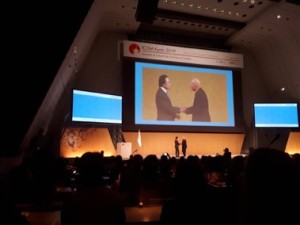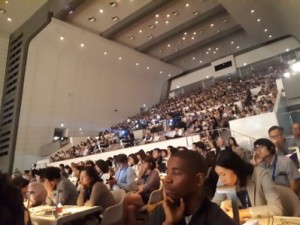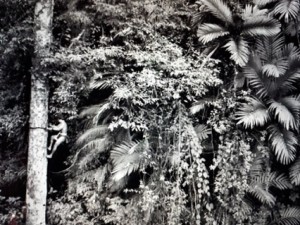Rossella Ragazzi
Associate Professor, Museum and Visual Anthropology
University Museum, The Arctic University of Tromsø
Salgado is plausibly the most known Brazilian photographer of his time. Appreciated for his magistral use of light, he has obtained several international prizes during his career. His photographs represent hard workers, peasants, marginal people, Indigenous people, proletarians, people in camps and diasporas, from all regions of the world. His latest project, “Genesis”, defined by himself as a sort of “antropologia planetaria”, brought him to the most remote regions of Himalaya, Siberia, Argentina, Galapagos, Central Africa, Amazon Forest, and other places, to render the intimate connections between humans, animals, plants, the elements, the geological layers of the earth, the environment.
Salgado enters the scene of the main auditorium of ICC in Kyoto, where thousands of ICOM delegates are keeping their breath. He walks assuredly but not in a hast, far from a ceremonial attitude, dressed like he dresses every day, no paper to be read, only the charisma of his physical and spiritual presence on stage. His tone of address, or “call”, has pathos and emotion in his voice. His English has a strong Brazilian accent, and the automatic translation sent simultaneously on a side screen, strives to detect his words, with the hilarious but also embarrassing result of deforming his speech into a surreal nonsense. For luck, his language, his tone, his “aura” are all exceeding the inaccuracy of the automatic translation, and the audience keep the attention and empathy that his lecture is meant to elicit, all the way throughout the presentation.

Who is Salgado? Born in 1944 in a farm owned by his father, inhabited also by 34 families of workers living in the estate. During his childhood, the property was, as he states, “50% of rain forest yet”. His childhood is in a heaven: plants, animals, a river crossing it, within a remote area that was not yet industrialized. It is nevertheless a farm that produces cattle, thousands of animals, a big scale: something that is not compatible with rain forest. Being the son of the owner, when he accomplished middle school and became 15, he had to move to a bigger town to continue his studies. He learned that Brazil was in a process of urbanization and industrialization, and parallel to his studies as economist, he became a leftist, an activist, and he also met his long-lasting love, Léila Wanick, who became his wife, his best friend, his associate for the rest of his life.
At the end of the 60s, the ferocious repression of a military dictatorship, has a decisive impact on the Salgados, who decide to migrate or exile to France, where Sebastião finished his PhD in economics and Léila became an architect. With her support, if not complicity, Sebastião left his safe job as economist after traveling in ex-colonies and third world countries as consultant, and started his career as photographer. He was described as an “anthropologist, activist, journalist-photographer”, but he felt he was doing more than that. He started living “totally inside photography” as he states. During thirty years, his reportages, books, exhibitions, required from him that he lives several months in the most remote and dangerous areas of Africa, Middle East and South America, to explore themes like labour, diaspora, warfare, famine, social injustice, migration, man-made catastrophes. If one has to find an encompassing concept in his gaze, it is the attention and exaltation of “human resilience”.
However, even though he is famous and became more and more acclaimed, a deep crisis emerged in his (professional) life, while he worked in Rwanda, at the end of the last millennium. He witnessed unbearable murders every day, and “I lost faith in human species” as he states. He feels that human kind is doomed to die out because of its own deeds. He falls deeply ill. He decides to leave all behind and go back to his original birth site. It is the farm of his father, that he inherited, being the sole male offspring of eight children. The estate had in the meantime become completely depleted of rain forest, because of sur-exploitation of breeding cattle and other incidents. He describes it stating: “to build our development we sacrificed our forests”. The “we” is sharing responsibility to a generic “we”-as-humans, but in fact, there is not reference in his statement to the colons, like his ancestors, that occupied Brazil and deforested it from a position of privilege, becoming the ruling class. However, with his project of restorative ecosystem, Salgado seems to be willing to compensate for that sur-exploitation, and he starts with Léila, who is once more key in the decision of the couple, to suspend the photographic business for some years, and to reconstruct that heaven of before his childhood, to restore it to its initial condition, to replant an entire ecosystem of rain forest, which they achieved, not without struggles and defeats, after five years of hard work.
Twenty million trees are replanted on the Salgados estate. This turns into a Foundation and a national park. They create the Istituto Terra. Big money, in the form of donations, support, sponsors, is given to this unique Brazilian project. These enterprise and actions are a cure also for the photographer. He starts to wish to come back to photography. This time, not to show suffering, injustice, despair, but beauty, pristine reality, majestic nature where human are just inhabitants, not masters or rulers. He wishes to make photographs as if it was a new beginning. From 2004 to 2011 he takes the most spectacular B&W images of awe, mystery, symmetric order of the planet in what became the paramount show and book “Genesis”. The Salgados wanted to “create a discussion on what we have of pristine on this planet”. “We exist yet” he said once, referring to the rudimentary but highly performant stone tools that some ethnic groups still use. For Salgado, they live in harmony and perfect balance with their environment: “I have been at the Brazilian National Indian Foundation, and only in Amazonia we have 110 groups that haven’t yet been contacted. We must protect the forest. We try to make a system of information for a new presentation of the planet, with these pictures”. What Salgado is presenting in Kyoto, is the work-in-progress of a new show that acts as a sort of close up into one of the aspects of “Genesis”: Amazonian wilderness and its diverse populations. The many delegates sitting and listening to him have the honour to see a work not yet completed. It is a momentous revelation. Salgado chooses to expose something yet to be completed, that took seven years of his professional life and he presents it without a written manuscript, nor by using a detached tone, but in a modest power-point with statistics figures about the Amazon Forest exploitation, and a music “slide show” with his magnificent photos, clearly in a phase of draft. We are thousands of specialists of heritage and museology, and he works with photography as memorialization, opposed to photo-making as communication, or feeder of social media. The emotion is palpable. Salgado starts his slideshow, a tribute to the pristine condition of Amazonia. The spectacular disclosure of the morning plenary session lends itself to a moment of revelation: in fact, the audience seems captured in an insomniac stupor.

There are no parallel panels in the morning session, when a keynote speaker is on stage: all the thousand delegates sit in perfect silence and share a momentous event.

The music used for “Amazonia” is somehow controversial in my eyes, although sublime. It is the composition of Heitor Villa Lobos, who disappeared himself into the Amazonian forest for several months, and was believed dead by his dears and followers. On the contrary, he came back liveliest than ever, and with material listened and collected in the Amazonian wilderness, that became inspiration and material for his masterpieces: Bachianas Brasileiras (1930-45). In Salgado’s show, the pervasive synchrony of these lyrical melodies, like the famous Aria No. 5, with his own paramount pictures, are enticingly sentimental and blur the power of the images themselves, that do not need any musical comments. This is the more problematic aspect in the presentation, to my modest advice.
Salgado denounced in his speech the aggressive politics of exploitation that the recent elected Government of Brazil implements, by letting the margins of the forest burn continuously in order to produce more land for cattle (a predicament that is not unknown to the Salgado family from his colonial past). Bolsonaro’s governance does not hesitate to incite corporations to cut as much wood as they want, with awful machineries that are destroying much more than trees, and repressing if not persecuting Indigenous communities that oppose such impingements. I feared that Salgado took a risk, by talking publicly like this, and it is possible that his dual citizenship, obtained during his exile in France, might protect him from being accused of dissent, once back in his homeland. Such a well-known, appreciated international “hero” as he is, would not do good advertisement to Bolsonaro Government if he was harassed due to his freedom in speaking out. As he says though, more than a president or a dictator, what is dangerous for places like the Amazon, is the industrial economic model imposed over the regions of the planet where this did not exist, that destroy the possibility of future sustainability. He appears courageous, outspoken, very honest, even if at moments his speech is more paternalistic than one would expect, especially when he calls in English “Indians” what in Brazilian is “Indios”, which should be possibly translated into “Indigenous”, because “Indians of the Amazon” in English sounds somehow a colonial appellation still.
Salgado’s portraits of peoples of Amazonia show them posing mostly in a fascinating stillness, a fixity that makes them perennially witnessing the condition that all humans should possibly have shared. In Salgado’s quest, it seems like if there is a research for innocence, beside showing skilfulness, beauty of appearance, sense of collegiality, elegance in all sorts of chores, and very advanced care for body-make up. The outfits, jewels, tattoo, weapons, tools, tissues, make-up, scarification, piercing, combs, animals’ skins, vegetal attributes, and various decorations used to make the body significant, are the texture of Salgado’s awesome black and white, as much as a corporeal signature of each individuality captured among the tribes of Amazonians. Parallel to this formal research, the rendering of textures of the land, the sky, water, rocks, leaves, plants and animal expressions, is tactful and majestic at the same time. One may also say that his style over-aestheticizes his subjects. His gaze is meditative, compassionate, subtle, and technically impeccable. There is no fear of capturing unnecessary details. Human and animal expressions, nakedness, or fierceness are rendered in highly sharpened contrasts. No ambiguity, no turning away, no voyeurism, either. He is a man that after more than 50 years in his photographic journey, can stand, contemplate, with empathy, and celebrate human dignity and synchronism with all what is breathing.
It is almost impossible to be critical in front of such an artist, and rather generous activist. His main preoccupation, all the years he spent in Amazonia, was not to bring any illness to these populations, since in the past one of the main plagues they had to endure from “first-contact” with the colons, was exactly a plethora of unknown sicknesses that decimated thousands of Indigenous peoples over the centuries.
Having spoken with many ICOM colleagues about his lecture, to test if my impressions were similar to theirs, I received some critical comments that I share here: some in relation to the choice of three key-note speakers and one in relation to Salgado’s presentation in particular. The fact that the three keynote speakers are famous artists/curators (one architect Kengo Kuma who gave the speech “The Age of the Forest”, one curator and visual artist Cai Guo Qiang, and one photographer, Salgado, whom is here reviewed), is not a neutral choice from ICOM’s side, one may guess. And this is welcomed, appreciated and in no case to criticize. However, the fact that they are three men, leaves many delegates perplexed, and not only female delegates. Today there are cultural/gender movements advocating the equal presence of genders in academic panels. When only men are invited to speak, many academics nowadays decline the offer, or they advocate with the organizers in such a way that other genders will be invited as well. What struck many colleagues at ICOM and myself, is that looking at the ceremonial opening and the key-note speakers, only few women were invited on the podium.
One of them did not take the word, for obvious reasons involved in her code of conduct (she is the Japanese Princess, Akichino in this case she is the Royalty siding her husband who held a speech). The other two women are Suay Aksoy, President of ICOM and the other is the Chair of the opening session. However, a large majority of male speakers was on the podium of the opening event. This has also to do with the fact that in Japan this inequality, when sitting on higher positions, is a cultural trend. It is not the only country though (China, Italy, Russia are just few other examples). This male majority was not repeated in most of the panels of the conference though. A quite balanced presence of male and female speakers characterized the remnant panels. And this is a point of favour for ICOM.
However, many delegates mentioned this unbalance and expressed the wish, together with mine, that in the future the main speakers and celebrities on the podium will be equally gender balanced. Moreover, two of the keynote speakers did not make time for a Q&A, alas. Salgado, differently from the other key-note speakers, had the tact of accepting a short Q&A. Really too short, but at least some Brazilian colleagues could express their gratitude complimenting him for his political courage, humanitarian and ecological message and his artistic achievement. They could also emphasize the importance of his work for the theme of ICOM 2019, maintaining that works like GENESIS and AMAZONIA are already part of the Visual Cultural Heritage of Humanity. His statement, released in a successive interview in Kyoto, is one of the most relevant one can bring home in the aftermath of his keynote address: “When you take the time to make photographs in a community, you become part of it, and the persons you take pictures of, your friends. In this way, you do not ‘take’ the pictures, but you ‘receive’ the pictures from the community”.

